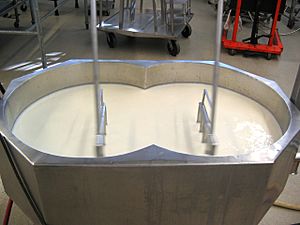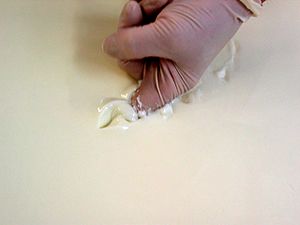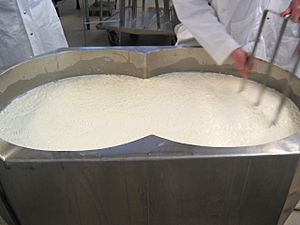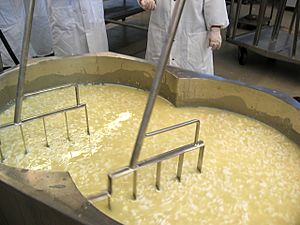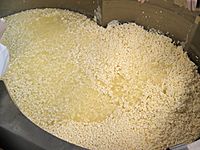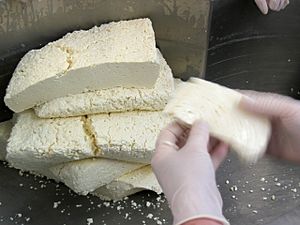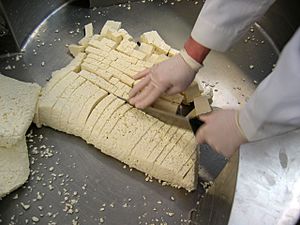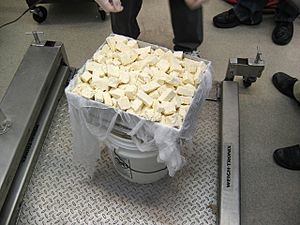Manufacture of cheddar cheese facts for kids
The making of Cheddar cheese involves a special step called cheddaring. This process makes Cheddar cheese different from many other cheeses.
Cheddar cheese gets its name from the village of Cheddar in Somerset, England. This is where it was first made a long time ago. Now, people make Cheddar cheese all over the world!
What Goes Into Cheddar Cheese?
Milk for Cheese
To make Cheddar cheese, people usually start with fresh milk. This milk needs to be "ripened" first. Ripening means letting tiny helpers called lactic acid bacteria (LAB) get to work. These bacteria eat the lactose (a type of sugar) in the milk and turn it into lactic acid. This makes the milk a bit more acidic, which is super important for making the milk thicken and form cheese curds.
Rennet: The Milk Thickener
Rennet is a special enzyme that helps milk turn into solid curds. Think of it like a magic ingredient that makes the milk clump together. Traditionally, rennet came from the stomachs of young calves. Cheese made with this type of rennet is not vegetarian or kosher.
Scientists have also found other ways to get rennet. Some plant extracts, like from nettles, can do a similar job. Today, many cheesemakers use a type of rennet made by special bacteria or fungi. This is often called "microbial rennet." It's a clever way to get the enzyme without using animal products.
Tools for Making Cheese
Cheesemakers use several important tools.
- Knives: They use special stainless steel knives to cut the cheese curds evenly. These knives have wires that slice through the soft curds.
- Vats: The milk is held in large vats. These vats often have hollow walls, like a jacket, where warm water can flow. This helps keep the milk and curds at the right temperature.
- Milling Machine: Later in the process, a milling machine is used. It cuts the big, matted cheese curds into smaller pieces. This makes it easier to add salt to the cheese.
How Cheddar Cheese is Made
Adding the Rennet
First, a small amount of rennet is added to the milk in the vat. For example, about 85 to 113 grams (3 to 4 ounces) of rennet might be used for every 450 kg (1,000 pounds) of milk. The rennet makes the milk proteins clump together and form curds. It's important to mix the rennet very well so it spreads evenly through all the milk.
Pure water is used to dilute the rennet. If the water isn't clean or has chlorine, the rennet might not work as well. This could mean less cheese is made.
Letting the Curd Set
After adding rennet, the milk mixture needs to sit quietly. This allows it to thicken and form solid curds. The mixture is kept warm, usually around 29 to 31 degrees Celsius (84 to 88 degrees Fahrenheit). Warm water flows through the vat's jacket to control the temperature. It takes about 30 to 40 minutes for the curd to set properly.
Cheesemakers check if the curd is ready by gently inserting a flat blade. If the curd breaks cleanly, like glass, it's ready for the next step!
Cutting the Curd
Once the curd is set, it's cut into small cubes. These cubes are usually about 6 to 16 millimeters (1/4 to 5/8 inch) in size. The size of the cubes affects how much moisture the final cheese will have. Smaller cubes mean less moisture, while larger cubes mean more moisture.
It's important to cut the curds quickly and cleanly. After cutting, the curds are handled gently to avoid losing any fat or protein into the liquid part, called whey. The curds are then allowed to rest for 10 to 15 minutes.
Cooking the Curd
Next, the curds are gently cooked. Hot water is added to the vat's jacket, raising the temperature to about 39 degrees Celsius (102 degrees Fahrenheit). The curds are stirred constantly during this step. This makes sure they cook evenly and don't stick together or overcook. This cooking step usually takes 20 to 60 minutes.
Draining the Curds
After cooking, the liquid whey needs to be removed from the curds. The whey is drained out of the vat, leaving the curds behind. When most of the whey is gone, the cheesemakers rake the curds to the sides of the vat. This creates two piles, allowing any remaining whey to drain down the middle.
Cheddaring: The Special Step
Cheddaring is what makes Cheddar cheese unique! It's a multi-step process where the curds are stacked and turned. This helps squeeze out more whey, makes the cheese less acidic, and gives Cheddar its special flavor and texture.
Setting the Curds
First, the curds are left to sit until they reach a certain acidity level.
Cutting Loaves
The curds are then cut into long "loaves," about 15 centimeters (6 inches) wide. After a few minutes, these loaves are turned over, and the stacking begins.
Stacking the Loaves
Every ten minutes, the loaves are turned over and stacked higher. This uses the weight of the curds to press out more moisture. For example, two loaves might be stacked together first. Then, two stacks of two might be put on top of each other. When the stacks get tall (usually four loaves high), the stacking stops, but the loaves are still turned every ten minutes. This process continues until the curds reach the right acidity.
Milling the Curd
Once the cheddaring is complete, the large curd loaves are cut into smaller pieces using a milling machine. This machine cuts the matted curd into pieces about 1.3 centimeters (1/2 inch) in size. As they are cut, the milled curds are constantly stirred so they don't stick back together.
Salting the Cheese
After milling, salt is added to the curds. The amount of salt varies, but it's usually between 1% and 3% of the cheese's weight. The salt must be mixed in very well. Salt helps remove even more whey, adds to the cheese's flavor, and stops it from becoming too acidic, which could make it taste bitter.
Packaging and Pressing
The salted curds are then put into special molds. These molds are used to press the curds tightly together, forming the familiar blocks of Cheddar cheese. After this, the cheese is ready for aging.
Aging the Cheese
The time Cheddar cheese ages depends on how mild or sharp it will be.
- Mild Cheddar is usually aged for two to three months.
- Mature (or sharp) and extra mature Cheddar are aged much longer, from 12 to 18 months.
- Some very old Cheddar has been aged for about ten years! The longer it ages, the stronger its flavor becomes.


